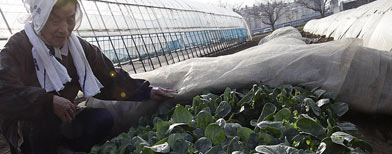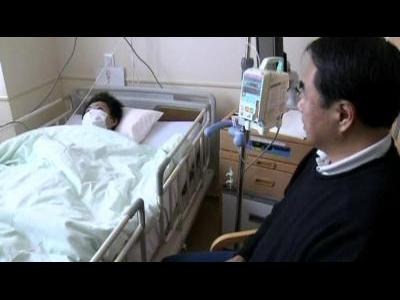
 AFP – Japan is battling a nuclear and humanitarian crisis, with engineers working to restore power to a stricken …
AFP – Japan is battling a nuclear and humanitarian crisis, with engineers working to restore power to a stricken … TOKYO (Reuters) – Global anxiety rose over radiation from Japan's earthquake damaged nuclear plant even as engineers had some success in the battle to avert disaster from the world's worst atomic crisis since Chernobyl.
The high-stakes drama at the battered Fukushima nuclear power complex is playing out while the Asian nation grapples with the rising death toll from the March 11 double disaster of an earthquake and tsunami. Officials estimate at least 21,000 people are dead or missing.
Technicians working inside an evacuation zone round the stricken plant on Japan's northeast Pacific coast have finally managed to attach power cables to all six reactors and started a water pump at one of them to cool overheating nuclear fuel rods.
"We see a light for getting out of the crisis," an official quoted Prime Minister Naoto Kan as saying, allowing himself some rare optimism in Japan's toughest moment since World War II.
Underlining the dangers, however, smoke rose briefly from two damaged reactors, forcing workers to evacuate for a while.
Away from the plant, mounting evidence of radiation in vegetables, water and milk spread jitters among Japanese and abroad despite officials' assurances levels were not dangerous.
The operator of the stricken plant, Tokyo Electric Power Company, said a small trace of radiation had been found in the Pacific sea waters nearby, but said levels were very low and posed no immediate danger.
"It's a lot more serious than anybody thought in the early days when we thought that this kind of problem can be limited to 20 to 30 kilometers," Peter Cordingley, spokesman for the World Health Organisation's (WHO) regional office, told Reuters.
"It's safe to suppose that some contaminated produce got out of the contamination zone."
However, Cordingley said there was no evidence of contaminated food reaching other countries from the Fukushima complex, which lies 240 km (150 miles) north of Tokyo.
Japan has urged some residents near the plant to stop drinking tap water after high levels of radioactive iodine were detected. It has also stopped shipments of milk, spinach and another local vegetable called kakina from the area.
"Radiation levels exceeding provisional standards have been found (in some products)," Chief Cabinet Secretary Yukio Edano said. "What I want the people to understand is that their levels are not high enough to affect humans. Eating these products just a couple of times would not affect people's health."
Experts say readings are much lower than around Chernobyl after the 1986 accident in Ukraine. Some warned against panic.
"You would have to eat or drink an awful lot to get any level of radiation that would be harmful," said Laurence Williams, professor of nuclear safety at the John Tyndall Institute in Britain.
"We live in a radioactive world -- we get radiation from the earth, from the food we eat. It's an emotive subject and the nuclear industry and governments have got to do a lot more to educate people."
There were no major reports of contaminated food in Tokyo, a city of about 13 million where many are staying indoors or wearing face masks. Some expatriates and locals left last week right after the accident.
Japan is a net importer of food, but has substantial exports -- mainly fruit, vegetables, dairy products and seafood -- with its biggest markets in Hong Kong, China and the United States.
JITTERS ABROAD
China said it is monitoring food imports from Japan but also took a swipe against panic by jailing a man for 10 days for spreading rumors about contamination of its waters.
State media said the computer company worker, who had urged people to avoid sea products for a year, was also fined 500 yuan ($76.13) and had confessed to "deep awareness of his mistake."
South Korea is expanding inspection to processed and dried agricultural Japanese food, from just fresh produce.
And in Taiwan, a top Japanese restaurant is offering diners a radiation gauge in case they are nervous about the food.
The United States is distributing potassium iodide to American personnel in Japan as a precaution against radiation exposure and "out of an abundance of caution" should the treatment be needed, a travel warning said.
The prospects of a nuclear meltdown in the world's third-biggest economy - and its key position in global supply chains especially for the automobile and technology sectors - rattled investors worldwide last week and prompted rare joint currency intervention by the G7 group of rich nations.
Damage is estimated at around $250 billion, making it the world's costliest ever natural disaster.
Japan's economic growth is expected to depress in the first half before reconstruction kicks in.
Tokyo's markets were closed for a holiday on Monday, but global stocks rose as risk appetite returned following progress in resolving the nuclear crisis. The yen slid on speculation of more Group of Seven intervention.
In a symbolic boost for Japan, billionaire investor Warren Buffett said the earthquake and tsunami were an "enormous blow" but in fact presented a "buying opportunity."
"It will take some time to rebuild. But it will not change the economic future of Japan. If I owned Japanese stocks, I would certainly not be selling them," Buffett said.
DEVASTATION
The official death toll - 8,805 by Tuesday morning - is certain to keep rising, with another 12,654 reported missing.
Police say more than 15,000 people probably died in Miyagi prefecture, one of four that took the brunt of the tsunami.
The 9.0-magnitude quake and ensuing 10-meter (32-ft) tsunami obliterated towns, which are now wastelands of mud and debris, leaving more than 350,000 people homeless.
Japanese are famed for their resilience, though, and there is little of the social chaos or looting that often accompany major global disasters.
In one devastated northern town, Rikuzentakata, rebuilding has even begun to help families living on mats in cramped shelters, separated from neighbors only by cardboard.
Steel structures, with walls and wood floors, have been erected at a hilltop school, to provide temporary housing.
Nearly 9.5 million foreigners visited Japan last year.
But, like Korean housewife Jin Hye-ryun who canceled a planned visit in May, many tourists are re-thinking.
"Safety is not guaranteed," she said. "Besides, think about people dying there. No one wants to go there to have fun."
(Additional reporting by Paul Eckert and James Topham in Tokyo; Yoko Kubota and Chang-ran Kim in Rikuzentakata; Jon Herskovitz and Chisa Fujioka in Kamaishi; Sui-Lee Wee in Beijing; Jungyoun Park in Seoul; Alister Doyle in Oslo; Writing by Andrew Cawthorne and Jason Szep, editing by Miral Fahmy)
 Slideshow:Japan hit by huge earthquake, tsunami
Slideshow:Japan hit by huge earthquake, tsunami  Play Video Earthquakes Video:Japan teen speaks of survival Reuters
Play Video Earthquakes Video:Japan teen speaks of survival Reuters  Play Video Earthquakes Video:Miracle quake survivor relieved to be rescued AP
Play Video Earthquakes Video:Miracle quake survivor relieved to be rescued APhttp://news.yahoo.com/s/nm/wl_nm/us_japan_quake
No comments:
Post a Comment